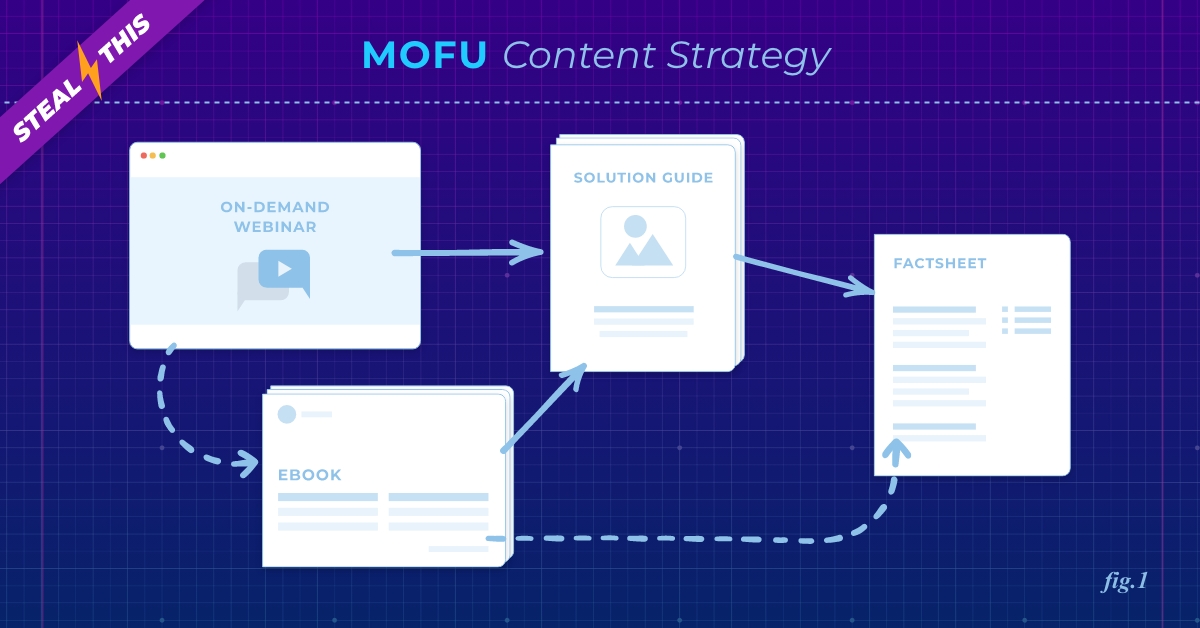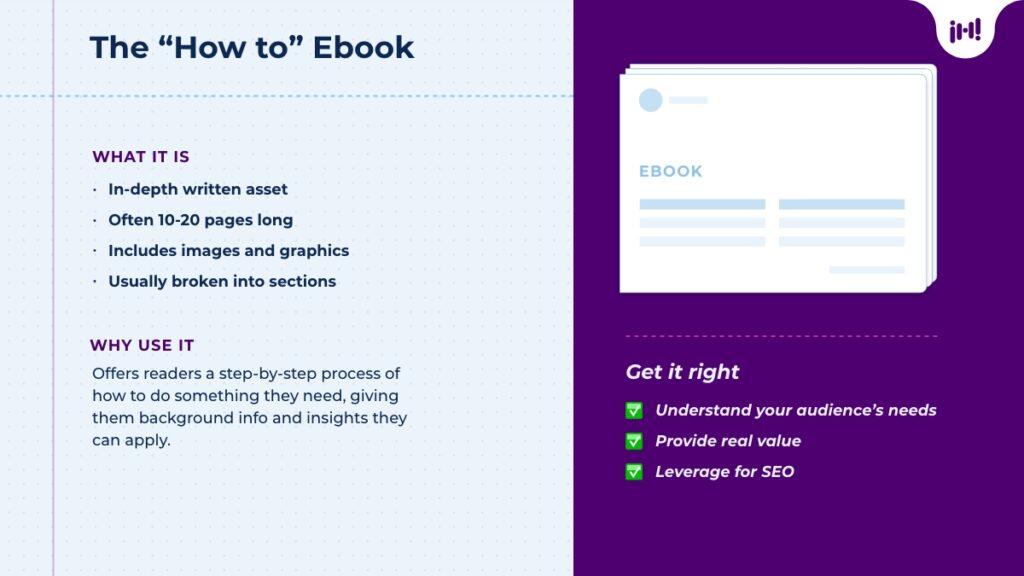Blog

Some prospects find you through referrals. Others from ad campaigns. That guy over there found you through a search engine and stayed for a couple of blogs. The good news is they’ve found you! The bad news? They’re not ready to buy. That’s why you need to have good MOFU (middle-of-the-funnel) content in your digital content strategy. And enough of it.
Jump to the four MOFU assets we want you to steal
MOFU content creates pathways from awareness content to decision content. Basically it takes prospects from “this is my challenge” to “this is the right solution for me.” It’s content that’s often used by both Marketing in demand gen campaigns and Sales in interactions with prospects—the lack of which is reported by both as the reason those campaigns don’t always work as well as they could.
It’s also content that buyers seek and find on their own during their research process—if it exists and you’ve created good pathways to it. Data shows your prospects are actively researching you. TechTarget’s recent media consumption research shows B2B technology buyers are engaging with an average of 12* pieces of vendor content during this research process. Without good MOFU content, those buyers are more likely to abandon you as an option in favor of a competitor who does have assets that answer their questions.
*I recognize that 12 pieces of content for a MOFU digital content strategy is a lot. That’s why I’m including ideas of derivative content for each asset, which will help you make the most of your content investment, reinforce messaging and create multiple touch points.

Get tips for how to create effective MOFU content here. Read More
So let’s make some middle-of-the-funnel content, shall we?

We chose to detail these assets because they offer high value by supporting multiple personas and stages of the buying process. While not every company will need all four, together they can create a robust MOFU digital content strategy. These assets not only meet many MOFU content goals but also provide excellent opportunities for derivative content. Below, we’ll explore each asset’s unique benefits and tips for getting them right.
Jump straight to the asset you want to steal:
- The “How to” ebook
- The on-demand webinar
- The solution/product guide
- The “Do I really need this” factsheet
The “How to” ebook.

This ebook offers a step-by-step process of how to do something they need—that you have expertise in—giving them detailed background info and actionable insights they can apply to their particular situation. Basically, figure out something your buyers want and need to do—that they don’t already know how to do. And tell them how to do it. They’ll 1) thank you for helping out, 2) recognize you really know what you’re talking about, and in the best case scenario, 3) think “wow I could just hire these folks to do this.”
The “how-to” asset checks these MOFU content goals:
✅ Educate and inform
✅ Address pain points
✅ Show why you’re the best option
✅ Provide value
Tips for getting the “how to” ebook right.
Understand your audience’s needs. Through buyer personas, search trends and/or conversations with Sales, identify the common pain points your audience faces in real life—not just what you think they’re dealing with.
Provide real value. The “how to” asset only works if your audience is getting in-depth knowledge and unique insights that they may not find elsewhere. They should finish the asset with the ability to take action, whether that’s making a decision, selling a plan to their own stakeholders or changing the way they approach the subject of the asset.
Leverage this piece of content for SEO. This is a great opportunity to rank for some tricky MOFU and BOFU keywords that don’t fit into your normal website or blog.
Three ideas for derivative content:
- Blog. Blog articles are never as detailed as an ebook, so either summarize your guide or choose specific aspects to publish as a blog.
- Infographics. Show the process outlined in your ebook in an easy-to-consume way that will appeal to more visual learners.
- Video guide. Turn it into a video where one or more of your experts (or even practitioners) walk the audience through the process. I prefer to start with the ebook before adapting it into a video, to save development time, since you’d need to research and write a script anyways.
The on-demand thought leadership webinar.

Anyone can create an on-demand webinar, even if you don’t already have a webinar program. Get 2-3 smart folks to talk about something relevant and useful for your audience—something they need and want to learn about. Record it, do some editing to make it a nice package, then publish and promote.
The webinar checks these MOFU content goals:
✅ Educate and inform
✅ Build trust
✅ Deepen relationships
✅ Provide value
✅ Address pain points
Tips for getting the webinar right.
Choose the right speakers. Good speakers will be more than just experts on your topic. They also need to be engaging—worth spending 30+ minutes watching.
Collab with external experts or partners. Invite respected industry thought leaders to co-host or participate. This gives your content an extra bump of credibility and can help you attract a larger audience if they co-promote.
Elevate video production. Some basic preparation goes a long way. Have presenters use decent mics or at least wear headphones, get them to set up in areas with good lighting and encourage the use of an external webcam at eye level, instead of their computer’s built-in camera.
Three ideas for derivative content:
- Publish on YouTube. If you have a good video that answers real questions, don’t restrict it to your website. Make it more easily findable.
- Blog. Take your transcript and adapt it into an article (or several) for your blog.
- Video snippets. Cut 10-60 second snippets with key takeaways or quotes, which can be shared through social media.
The solution/product guide.

A lot of company websites struggle to effectively describe their products and services—or keep up with changing offerings. Plus, there’s only so much you can say there. A product or solution guide bridges that gap by offering up-to-date information about a company’s products or services, highlighting key features, benefits, competitive differentiation and use cases. With more real estate, and the ability to adapt different versions to particular audiences, you’re able to answer the more specific questions buyers have as they research.
The guide checks these MOFU content goals:
✅ Educate and inform
✅ Show why you’re the best option
✅ Help explain what you’re offering
✅ Answer questions that keep moving the process forward
Tips for getting the guide right.
Leverage design. Use high-quality images, diagrams and infographics to make the guide visually appealing and easier to understand.
Make it easy to grasp. Use simple, straightforward language to describe your solutions, avoiding overly technical jargon.
Provide comprehensive information. In addition to describing key features, functionalities and benefits of your product or solution, include side bars and sections with additional context. These could include use cases, testimonials, competitive analysis, statistics, FAQS and best practices.
Maintain version control. Indicate the version and date of the guide to ensure readers know they are viewing the most current information.
Three ideas for derivative content:
- Sales presentations. Develop slide decks for your sales team to use in pitches.
- Fact sheets. Provide a concise, easy-to-digest summary of key features, benefits and specifications, tailored for quick reference and distribution.
- White paper. Offer an in-depth, authoritative exploration of a specific feature or benefit, backed by detailed data, research and case studies.
The “Do I really need XYZ” fact sheet.

If you know your buyers (or members of your buying team) have specific hang-ups on aspects of your offering, this asset is your opportunity to address those concerns proactively. We had a client with a solution a lot of organizations wanted. However, there was a first step they were bundling with it that made the main solution so much more effective, but was often misunderstood as cross-selling. A fact sheet that clearly explains why that step is critical could clear up that doubt before it ever manifests and gets in the way of the sale.
The fact sheet checks these MOFU content goals:
✅ Educate and inform
✅ Alleviate worries and concerns
✅ Answer questions that keep moving the process forward
Tips for getting the fact sheet right.
Succinctly address misunderstandings. Use a comparison chart to show the benefits of doing what you want them to buy—or the drawbacks of not. Alternatively (or additionally), add a case study or real-world example to illustrate its impact.
Create an asset that does double duty. When done right, this asset can work for both researching users and decision-makers. You want to go in-depth enough to convince someone at this stage of the buying process that your solution or differentiators are important. Yet, you also want to make it succinct enough to provide a decision-maker with a quick summary of important points.
Three ideas for derivative content:
- Blog. Turn the fact sheet into a narrative to publish on your blog.
- Case study. Often case studies present the success of the solution as a whole. In this case, tailor your case study to the use case presented in the fact sheet.
- Infographic. Summarize key points from the fact sheet to be shared on social media.
Other great pieces of MOFU content to complete your digital content strategy.
Remember: Not every company needs every single piece of MOFU content—it all depends on what your buyers need at that stage of the buying process.
- Demo videos
- Case studies (here are our success story examples)
- Interactive tools (see our tools for examples)
- Live Q&A session
- Self-serve pricing/ROI calculators
- Buyer’s guides
- Video guides (check out our latest video guide)
- Templates and checklists

Creating MOFU content with the help of AI? Read this blog first. Read More
The Iron Horse insight.
Your middle of funnel digital content strategy should focus on aligning your audience’s problems with your solutions, ensuring each asset is crafted to guide readers toward making a decision. Don’t be afraid to “give away knowledge”—your expertise will drive qualified buyers down the funnel.
Subscribe to our blog.
Get unstuck with the most interesting business ideas and our insights delivered to your inbox.